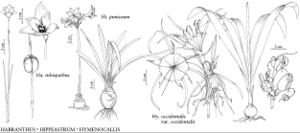Habranthus
Bot. Mag. 51: plate 2464. 1824.
| Taxon | Illustrator ⠉ | |
|---|---|---|
 | Habranthus tubispathus Hippeastrum puniceum Hymenocallis occidentalis var. occidentalis | Yevonn Wilson-Ramsey Kimberly J. Martin Yevonn Wilson-Ramsey |
Herbs, perennial, scapose, from bulbs. Bulbs black or brown, tunicate, ovoid or globose, sometimes with long neck. Leaves deciduous, sessile, erect or recumbent, bases overlapping, sheathing; blade linear, rarely exceeding 2 cm wide, smooth. Scape hollow. Inflorescences umbellate, 1 [–4] -flowered, spathaceous; spathe proximally tubular; bracteoles sometimes present. Flowers declinate [to suberect], somewhat zygomorphic; perianth connate proximally, funnelform, shortly tubular basally, 2–8 cm; tepals subequal; filaments inserted on tepals distal to perianth-tube, fasciculate [semifasciculate], declinate and recurving distally, filiform, in sets of 4 different lengths; anthers submedially dorsifixed, usually parallel with floral axis, linear-oblong; ovary inferior; style filiform; stigma 3-fid, lobes linear; pedicel rarely absent, hollow. Fruits capsular, 3-locular, thin-walled, subglobose or ± oblate. Seeds numerous, dark-brown to black, flat, D-shaped, obliquely winged, lustrous. x = 6.
Distribution
se to sc United States, Mexico, South America
Discussion
Species ca. 30 (2 in the flora).
Habranthus species have at times been included in the genus Zephyranthes. The somewhat zygomorphic flower of Habranthus is clearly distinguished by filaments of 4 different lengths, which are fasciculate to semifasciculate, and always longer than the perianth tube. The actinomorphic flower of Zephyranthes is distinguished by filaments of two lengths (sometimes subequal), which are not fasciculate and are spreading except when shorter than the perianth tube.
All measurements were taken from pressed, dried specimens. Generally, the maximum width of a fresh leaf would be about one and one half times that reported here.
Selected References
None.
Lower Taxa
Key
| 1 | Perianth bright yellow or orangish yellow, less than 4 cm; stigma borne near top of stamens; leaf blade not exceeding 4 mm wide. | Habranthus tubispathus |
| 1 | Perianth pink, 6+ cm; stigma borne ca. 1 cm beyond stamens; leaf blade more than 5 mm wide. | Habranthus robustus |
"wide" is not a number."thicker" is not a number.